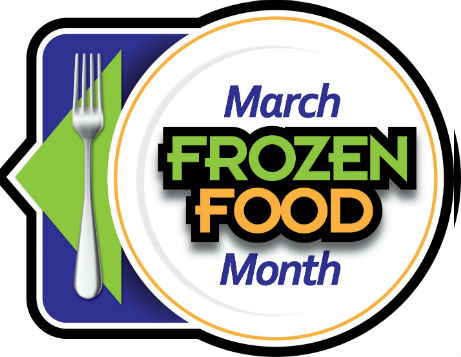
by Heidi Copeland | Feb 28, 2019
March is Frozen Food Month. In fact, the National Frozen & Refrigerated Foods Association (NFRA),Inc., likes to suggest that there is MEALTIME MAGIC in the FROZEN AISLE. I could not agree more!
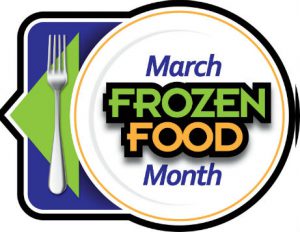
March is Frozen Food month. Photo Source: with permission from Frozen Food Alliance
Frozen foods are a smart choice. Frozen foods are always in season, last much longer than their fresh counterparts, are convenient, economical and full of variety. Plus, frozen foods can be portioned and packaged in ways that don’t leave anything to waste.
A lot has changed since 1925 when Clarence Birdseye was issued U.S. Patent #1,773,079, to freeze fish. This U.S. Patent marked the beginning of today’s frozen foods industry. In 1927, he extended the freezing process to quick-freezing meat, poultry, fruit, and vegetables. Birdseye’s initial introduction of 26 frozen foods has morphed to so many frozen products that the NFRA boasts over 3,700+ different choices. There is something FROZEN for every taste and every budget!
The modern day frozen product is generally supercooled at temperatures below -54°F. This supercooled fast freezing process produces smallish ice crystals that help foods retain their personal characteristics. Additionally, a lot of research goes into commercially frozen food’s packaging. Many frozen products can go directly from freezer to microwave, oven or even a pot of boiling water. Packaging must also consider the constraints of the home freezer knowing that its average temperature is around 0° or a bit below.
Although cold temperatures like 0°F or below puts a temporary hold on many biological processes microorganisms are not always killed off during freezing. It is important to recognize that proper care must be taken preparing some frozen foods.
In addition, when foods are frozen for extended periods of time or are frozen improperly, freezer burn can begin to develop on the food’s surface. Freezer burn happens when moisture in the outer layers of the food evaporates into the dry freezer air, leaving behind empty pockets in the tissue of the food. Freezer burn on meat is visible as brownish-white discolorations and on other foods dry, white spots. While it is not harmful to eat, freezer burn can adversely affect the flavor and texture of food.
It is easy to prevent freezer burn. One can easily reduce the food’s exposure to air through the use of correct wrap before storing food in the freezer. The National Center for Home Food Preservation (https://nchfp.uga.edu/how/freeze.html) has excellent information on how the use of proper packaging materials can protect the flavor, color, moisture content and nutritive value of foods from the arid climate of the freezer.
Frozen food packaging depends on the type of food to be frozen. In general, packaging materials must have certain characteristics:
- Moisture vapor resistant
- Durable and leakproof
- Not become brittle and crack at low temperatures
- Resistant to oil, grease or water
- Protect foods from absorption of off flavors or odors
- Easy to seal
- Easy to mark (with both content and date)
Additionally, a full freezer is the most energy efficient.
Posting a frozen foods inventory (list) near the freezer and keeping it up to date by listing the foods and dates of freezing is helpful. Remembering also to rotate foods in the freezer. An easy acronym for this is FIFO… First-In, First-Out. In other words, use the food stored the longest before you use the newest.
Moreover, purchase a thermometer if your freezer does not have an automatic temperature display. A freezer should be maintained at a temperature of 0°F or lower. At higher temperatures, foods lose quality much faster.
Most recently, a woman from North Carolina, Sheila Pulanco Russell, is credited with bringing a lifehack to the masses with her “how to” Facebook posting. I think it is a good thing to know. It is called the One Cup Tip. All it entails is putting a cup of water in the freezer, freezing it solid, and then placing a quarter on top of it and leaving it in the freezer.
When you return from an extended out of town trip you know if your power was out. It the quarter is sitting at the bottom of the cup you know your power was off too long and that your frozen food is not safe to eat. If the coin is in the middle of the cup, the outage was fairly short and your food should be good (frozen foods that still have their crystals are safe to eat and refreeze). If the coin is still on the top, then there was no power outage or just a quick one and all is well. Note: no one wants food poisoning, so if you are in doubt, throw the food out.
Have questions? Don’t hesitate to call your local county extension agent from the Cooperative Extension office; they’re free!
Heidi Copeland
Family and Consumer Sciences Extension Agent, III
University of Florida IFAS Extension
615 Paul Russell Road
Tallahassee, Florida 32301
hbc@ufl.edu
(850) 606-5203
The Foundation for The Gator Nation
An Equal Opportunity Institution
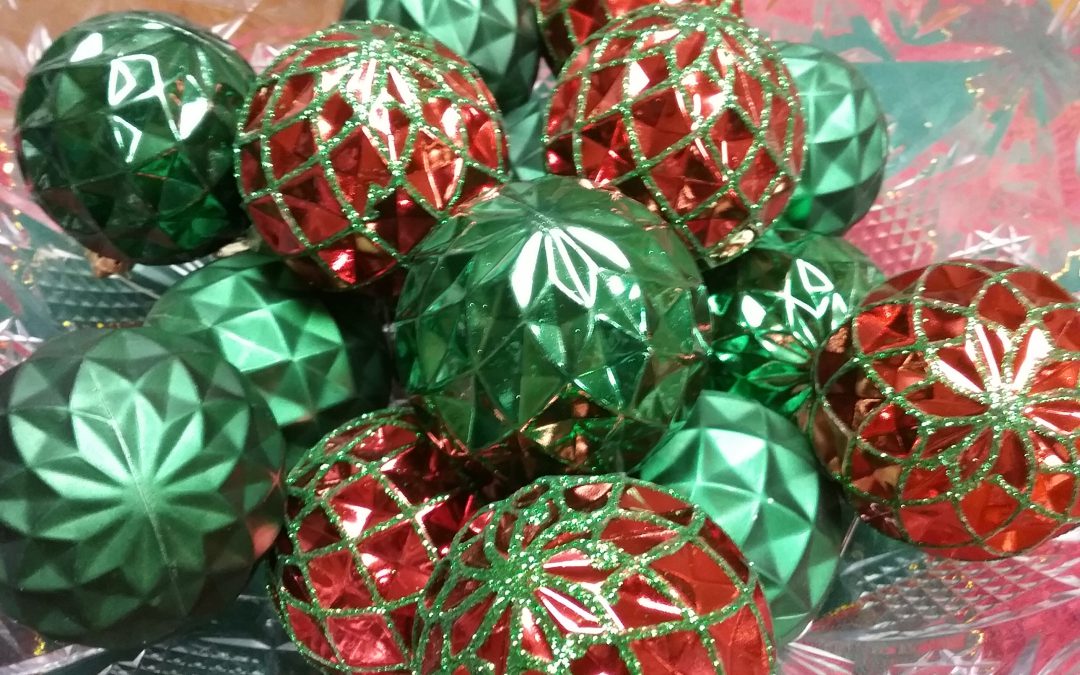
by Judy Corbus | Dec 3, 2018
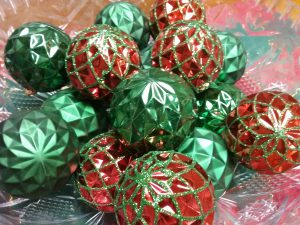
Photo source: UF/IFAS Northwest District
The holiday season is here and, with it, many colorful decorations, delicious treats, and fun events. There also are hidden dangers that can mar this special time of year if we aren’t careful. Follow these twelve tips for a safe holiday celebration:
- To reduce fire risk, do not connect more than three strings of incandescent lights. Follow label guidelines for stringing together LED lights. Check lights for frayed or exposed wires, loose connections, and broken sockets and replace as needed.
- Place candles on stable surfaces away from trees, curtains, and other flammable items and out of reach of children. Never leave burning candles unattended or sleep in a room with a lit candle. Consider using battery-operated candles.
- Use caution when decorating with “angel hair” and artificial snow. Angel hair is made from spun glass and can irritate eyes and skin; always wear gloves when handling or use non-flammable cotton instead. Artificial snow can irritate your lungs if inhaled; follow package directions carefully.
- Keep kids and pets in mind when decorating the tree. Place breakable ornaments or ones with metal hooks near the top out of reach of little hands, playful paws, and wagging tails.
- Use a sturdy step ladder, not chairs or other furniture, to reach high places. Get someone to “spot” you and assist with handing or taking items.
- If you use a fireplace, have your chimney checked and cleaned at least once a year by a certified chimney sweep. Cleaning removes soot and other by-products that can lead to chimney fires and carbon monoxide intrusion into your living space.
- Use special care when giving toys that use coin lithium batteries to children. Older children’s devices with these batteries can be enticing to young children. Ingestion of button batteries can cause serious injury or death. Lock away spare batteries and closely supervise young children around products with button batteries. In case of ingestion, contact the 24-hour National Battery Ingestion Hotline, (800) 498-8666.
- If you want to fry a turkey, consider using an oil-less turkey fryer or purchase a fried turkey from a professional establishment. The Consumer Product Safety Commission reports that since 2002, there have been 168 turkey-related fires, burns, explosions, or carbon monoxide poisoning incidents, 672 injuries, and $8 million in property damage. Don’t add to the statistic count!
- Use a food thermometer to ensure meat reaches a safe internal temperature. Click here for a convenient temperature chart.
- Refrigerate food within two hours. Cut leftover meat in small pieces and store foods in shallow containers so they will chill quickly. Use leftovers within four days or freeze or discard.
- Reheat sauces, soups, and gravies to a rolling boil before serving.
- Wash your hands frequently with soap and warm water to reduce your risk of illness.
Have a happy, healthy holiday season!
Sources:
National Safety Council
Chimney Safety Institute of America
Electrical Safety Foundation International
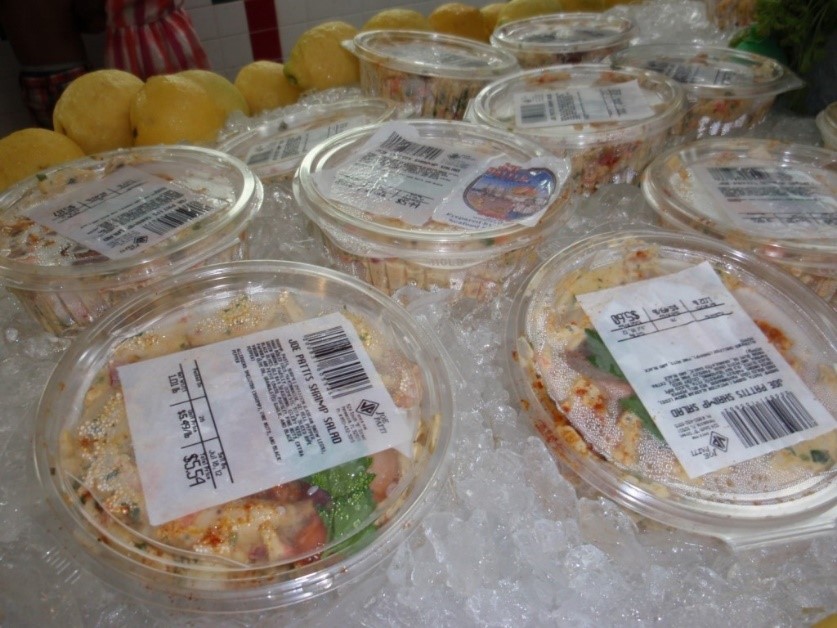
by Dorothy C. Lee | Aug 24, 2018
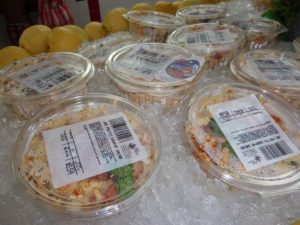
Photo source: UF/IFAS Northwest District
Fish and shellfish are easy to prepare and swimming with nutritive value. Fish and shellfish have become an even more important part of the diet as people turn to more healthful eating. People are choosing fish and shellfish more frequently for several reasons. It is economical, versatile, high in nutritive value, quick and easy to prepare, and it tastes good.
When purchasing fish, look for bright, clear, bulging eyes; reddish or pink gills; tight, shiny scales; firm, elastic flesh that springs back when pressed; and a pleasant saltwater-like odor.
Fish and shellfish are best if cooked the day of purchase but can be stored no more than two days in the coldest part of the refrigerator, preferably on ice. Frozen fish and shellfish should be kept solidly frozen until ready to thaw. Frozen seafood will remain fresh for four to six months. Cook seafood immediately upon thawing. Do not thaw fish at room temperature or in warm water because it loses moisture and flavor. Never refreeze uncooked fish.
Most fish and shellfish can be cooked using a variety of methods. Fish and seafood can be broiled, grilled, deep-fried, poached, steamed, baked, pan-fried, and sautéed. Care must be taken not to overcook fish or seafood. Fish are done when the flesh, pierced at its thickest point with a fork, flakes easily, and turns from translucent to opaque. Proper cooking develops flavor, softens connective tissue, and makes protein easier to digest.
Many seafood aficionados prefer flavoring their dishes with small amounts of salt, pepper, and occasionally lemon. The delicate taste of seafood blends exceptionally well with a variety of herbs, spices, and seeds, as long as these seasonings are used sparingly.
The next time you are in the neighborhood of your local seafood market, stop in. Remember that fish and shellfish from the Gulf are nutritious, economical, quick and easy to prepare, and taste great. So, enjoy local fish and seafood today!
Sunshine Fillets
2 pounds red snapper fillets or other fish fillets, fresh or frozen
2 teaspoons grated orange peel
1 teaspoon salt
3 tablespoons butter or margarine, melted
Dash nutmeg
2 tablespoons orange juice
Dash pepper
Thaw frozen fillets. Cut fillets into 6 portions. Place fish in a single layer, skin side down, in a well-greased baking dish, 12 x 8 x 2 inches. Combine remaining ingredients. Pour sauce over fish. Bake in a moderate oven, 350°F, for 20 to 25 minutes or until fish flakes easily when tested with a fork. Makes 6 servings.
Shrimp Kabobs
1 pound frozen raw, peeled, cleaned shrimp
1/3 cup butter or margarine, melted
1 teaspoon salt
2 large green peppers, cut into 1-inch squares
Dash pepper
8 slices bacon, cut into sixths
3 cans (4 ounces each) button mushrooms, drained
Thaw frozen shrimp. Alternate shrimp, bacon, mushrooms, and green pepper on 48 skewers or round toothpicks, approximately 3 inches long. Place kabobs on a well-greased broiler pan. Combine remaining ingredients. Pour half of the sauce over kabobs. Broil about 4 inches from source of heat for 5 to 7 minutes. Turn carefully and baste with remaining sauce. Broil 5 to 7 minutes longer or until shrimp are pink and tender. Makes approximately 48 hors d’oeuvres.

by Amy Mullins, PhD, RDN | Aug 24, 2018
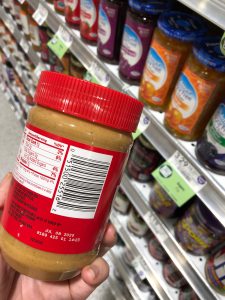
Photo source: UF/IFAS Northwest District
If your family is like most, grocery shopping is a dreaded weekly task. Typical shoppers usually have an idea of what they plan to purchase based on a previously made shopping list. Even then, it’s easy to go astray with impulse purchasing, bargain prices, and buy-one-get-one free opportunities that simply can’t be passed up! Before you know it, the shopping cart is loaded with delicious treasures just begging to come home with you.
Now that you have done the shopping, transported it home, and begun to put food items in their appropriate storage places, you realize the refrigerator, freezer, and pantry are cramped and nearly full. On a related aside, you should see my parents’ pantry. They have enough cans, boxes, and packages to feed their entire neighborhood…twice! Not to mention the two full size refrigerator/freezers that are bursting at the seams. Like my parents, I suspect many of us have a food overbuying addiction. So what happens next? Well, it’s time to clear out the old and make way for the new, of course. But how do you know what to purge and what is still good to keep?
Food Date Labeling Confusion and Food Waste
Standard or uniform language for food product dating does not exist in the U.S., which makes things tricky when it comes to deciphering expiration dates. Current Federal regulations do not require product dating (excluding infant formula), but instead allow food manufacturers to voluntarily set and display these dates on product packaging. With the lack of Federal measures, product dating enforcement is left up to individual states, resulting in consumer confusion over food safety. The U.S. wastes close to an estimated 40% of food produced annually, which equals approximately 160 billion pounds (Harvard Food Law and Policy Clinic). Of that, confusion over the meaning of date labels seems to be responsible for roughly 20% of safe and edible food wasted by consumers. Undoubtedly, this hurts purchaser’s pocketbooks and results in $29,000,000,000 of wasted consumer spending yearly (Food Date Labeling Act of 2016, 114th Congress 2D Session).
Food Quality vs. Food Safety
While cleaning out the pantry and cold storage, I also have been guilty of trashing perfectly good food. So many of us unknowingly accept the stamped date as common law not to be questioned. So what does that date actually mean?
The “open” date used by the manufacturer or retailer on food packaging is passively thought of by the consumer as the “expiration date,” or the last date a food can safely be eaten. This is a very common misconception. Food safety is not represented by this date, but rather it refers to product quality and freshness. Dates determined by food companies take into consideration such factors as ingredients, product characteristics and packaging, as well as time and temperatures associated with distribution, retail sale, and storage.
With no current standards in place, a variety of food date phrases are utilized which often are misleading to retailers and consumers. Most commonly used phrases include:
- “Best If Used By/Before” indicates when a product will be of best flavor or quality.
- “Sell-By” indicates to the retailer when the product should no longer be displayed for sale.
- “Use-By” is the last date recommended for use of the product at peak quality. This is only a safety date when used on infant formula packaging.
It’s important to remember that open dates on food products ONLY reflect food quality and NOT food safety (except for infant formula). For a list of specific foods and recommended storage time frames, check out the FoodKeeper resource at FoodSafety.gov.
Food Spoilage
Knowing the signs of spoilage will help you determine if a food is no longer fit for consumption. Although the quality date may have passed, the food is safe until it begins to spoil. Spoiled food may have a different smell, taste, and/or texture with sometimes visible discoloration. This occurs when environmental conditions (such as temperature, moisture, and oxygen) are introduced which support the growth of bacteria, molds, or yeasts. Given enough time, these microorganisms multiply rapidly and affect the safety of the food. If perishable items are not handled and stored properly, spoilage occurs much more rapidly. Learn more about proper refrigeration and food safety.
Do Your Part at Home
- Plan meals in advance and make a specific grocery list. Check the refrigerator, freezer, and pantry to utilize what you already have on hand.
- Don’t overbuy! Especially be aware not to purchase excess perishable items that are likely to spoil quickly. These may be foods that require cold storage, fresh bakery items, and fresh produce.
- Always look for and compare date labels of an item; choose the one with a later date.
- Store foods promptly and properly for food safety and best quality. Discard potentially hazardous cold food items that have not been properly refrigerated for 2 hours or more.
- Keep a thermometer inside the front of your refrigerator and check it regularly to be sure it stays below 40 degrees F.
- Thaw foods safely! Thawing in the refrigerator is the safest way, but using cold running water or defrosting in the microwave are acceptable ways to speed up the process. Never sit foods out at room temperature to thaw!
- Recognize the signs of food spoilage and promptly discard foods that smell funny, have off-flavors, obvious mold growth, or sticky or slimy textures (such as fish, poultry, and deli meats).
- Evaluate each item in your pantry and consider whether or not it’s something you want to continue to store and use or want to remove.
- High temperatures affect the shelf life of shelf-stable foods so it’s important to store dry goods and pantry items in temperatures at or below 85 degrees F. Use the “First In First Out” (FIFO) method of rotation, using older items before newly purchased ones. Read more about Shelf Stable Food Safety.
- Discard cans that are rusty, bulging, or leaking, as they are at a high risk for containing the deadly pathogen that causes Botulism. Never taste suspicious foods! Take extra caution by disposing of cans and jars into a tightly closed plastic bag before placing in an outside trash receptacle.
Help Families in Need & Keep Unused Wholesome Food Out of Landfills
Mistakenly discarded food products, not only is the U.S. but globally, have created a sad cascade of wasted resources and money with increasingly negative environmental and social implications. Food banks and local community organizations have plenty of under-served and needy families who can benefit! Remember, it’s safe to donate dry and canned goods, perishables, and other food related items that are beyond the quality date of the product.
Find a food bank near you.
We all can do our part to reduce the amount of wasted food, save money, help the environment, and help our communities!
Additional Resources:
https://www.usda.gov/oce/foodwaste/sources.htm
https://www.usda.gov/oce/foodwaste/resources/donations.htm
USDA Food Safety Information, Food Product Dating
USDA Food Labeling Fact Sheets
by Melanie Taylor | Jul 8, 2018
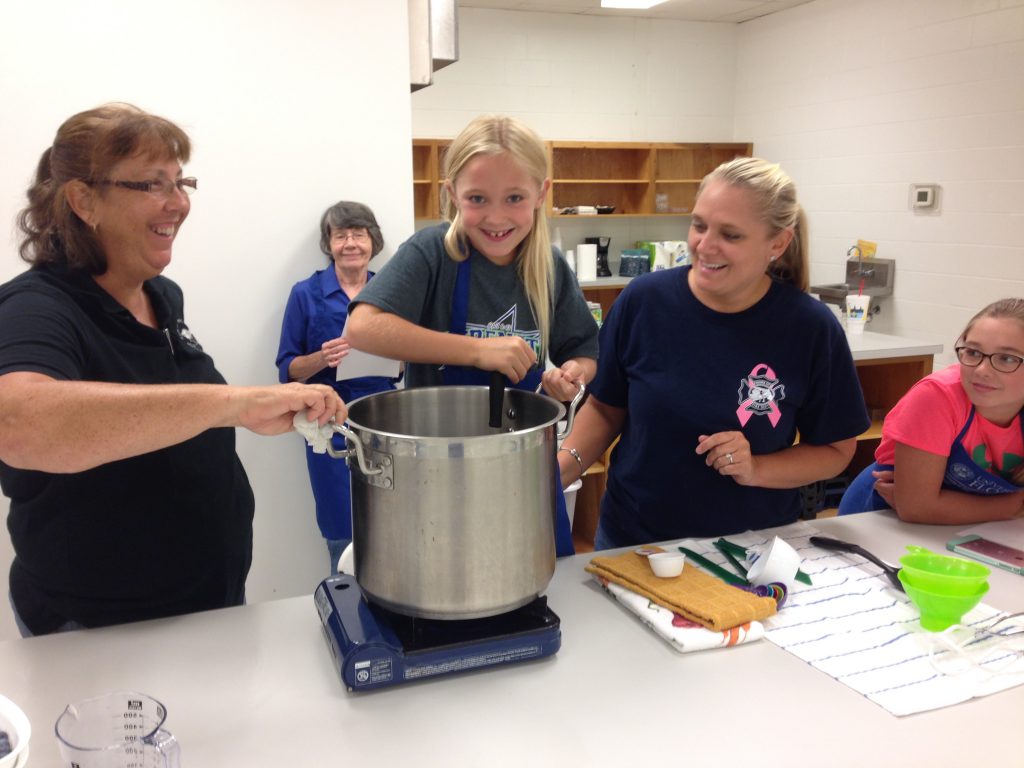
Youth learn food preservation skills. Photo source: Melanie Taylor
At this point in the summer, many parents are at a loss for what to do to keep their children engaged and “off the couch.” How about a focus on healthy eating and food preservation? If you have a backyard garden be sure to pick the fruits and vegetables at their peak readiness. If you do not have a garden make a family trip to the local farmers market and/or a local u-pick farm.
Of course, fresh fruits and vegetables are full of nutrition and taste, but if you have or buy more than your family can eat in a few days’ time, be sure to make preparations to teach your children how to preserve those foods to eat later in the year. There is nothing more enjoyable than having fruit jam on biscuits or summer vegetables in your soup during the cold depths of winter.
There are six different methods of food preservation to teach your children. They are boiling water/water bath canning, making jam, pickling, freezing, drying, and pressure canning. The easiest method being freezing and the most complex and time consuming being pressure canning. No matter which ones you choose to teach your children be sure to follow valid recipes and procedures. Family and Consumer Science Extension Agents always recommend using the most current recipes and procedures from The National Center for Home Food Preservation, which are maintained at https://nchfp.uga.edu/. The National Center for Home Food Preservation is your source for current research-based recommendations for most methods of home food preservation. The Center was established with funding from the Cooperative State Research, Education and Extension Service, U.S. Department of Agriculture (CSREES-USDA) to address food safety concerns for those who practice and teach home food preservation and processing methods. Many of the recipes are available for free on the website, or you can order the 6th edition of the “So Easy to Preserve” food preservation book at https://setp.uga.edu/.
Specific to children, there is also a Put It Up! Food Preservation for Youth curriculum through the University of Georgia, which is a series of informal educational lessons that guide youth to explore and understand the science of safe food preservation. This free curriculum can be found online at https://ugeorgia.ca1.qualtrics.com/jfe/form/SV_a5Y4IfBZ2Vh0EIt after a quick questionnaire of how you plan to use the curriculum.
Teaching these food preservation skills to your children will be a fun-filled and very educational opportunity. Be sure to use the above resources to assist you in the food safety methods to be certain your products are safe for consumption. Enjoy this special time in the garden and kitchen with your children this summer.
Resources:
National Center for Home Food Preservation https://nchfp.uga.edu/
“So Easy to Preserve” https://setp.uga.edu/
Put It Up! Food Preservation for Youth https://ugeorgia.ca1.qualtrics.com/jfe/form/SV_a5Y4IfBZ2Vh0EIt










